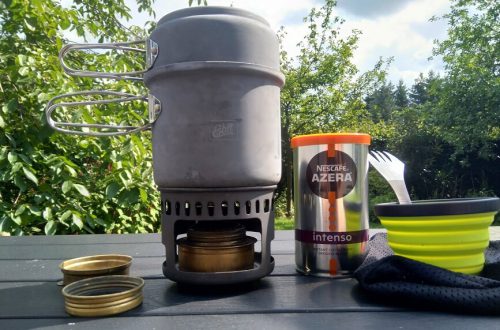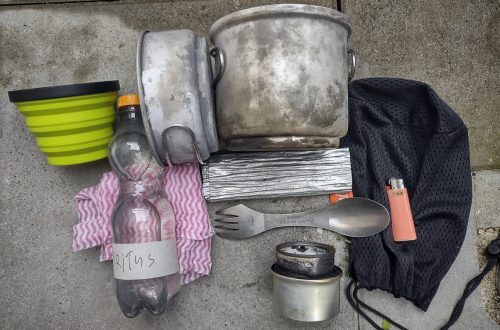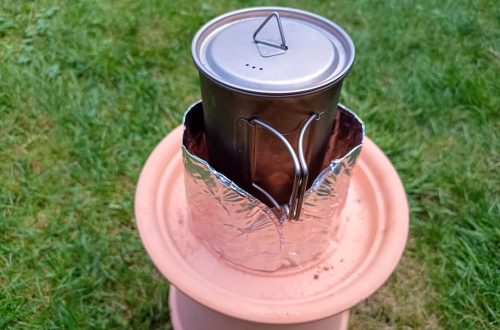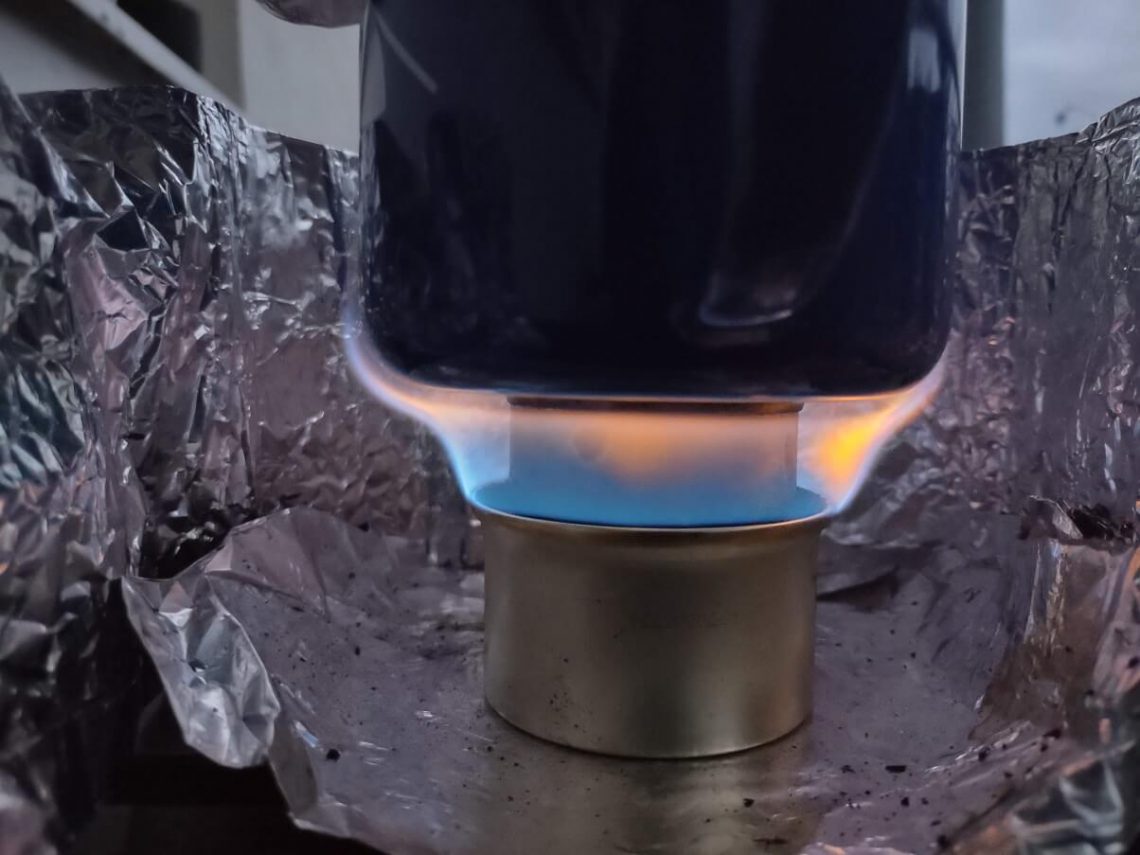
Fancy Feast Alcohol stove
There are many different types of alcohol stoves, and I tried quite a few over the years. I think I finally landed on my favorite DIY alcohol stove, like many others, on the Fancy Feast Alcohol stove. Let’s take a look at how you can make it, and how it can perform.
Alcohol stoves can have several advantages over other options for backpacking and hiking, the fuel is in most countries around the world easy to find. And available in many Gas Stations, Grocery stores, or even hardware stores. This makes them a good choice for many people in certain types of hikes, there is also a big DIY community around every Alcohol stove.
Quick jump list
- Ease of construction
- Materials needed
- The Wicking Material
- Assembly and testing
- Ease of use of the Fancy Feast stove
- Quick boil times
- Long-lasting, and at the same time easy to replace
- Improved Designs
Affiliate links may be mentioned in this article, by purchasing a product through those links I may receive a kickback. At no extra cost to you.
There are thousands of designs and variations for every known type. They can be broken down into a few sections though and types. The Fancy Feast stove falls somewhere in between a pressurized version and the wicked alcohol stoves. I will not be talking about the regular SuperCat Can stove, but the Fancy Feast Stove with wick, consisting of a Fancy Feast cat food can, and a Tomato paste can. Let’s get stuck into the Fancy Feast Stoves, how they work and why I think you should give them a shot for your next hike!
Ease of construction
The Fancy Feast Stove is one of the easiest to make out of all the Alcohol stoves, we have all seen the beer can stoves and other penny stoves. Getting those right has proved difficult for beginners and can be a lot of fidgeting to get them exactly lined up, and pressed together. They can also require a lot of different tools that maybe not be accessible to anybody that doesn’t have a garage. Since I moved into an apartment, I lack the tools and space for a lot of more involved projects. The Fancy Feast alcohol stove can be made with a can opener, and a ruler to measure (can be eyeballed though). And a small pocket knife, in my case a Victorinox Classic.
Materials needed
The materials needed for the Fancy Feast Stove consist of just two cans when it comes down to it. Which cans can be tricky of course, but the name betrays already one of them. Take a look in the cat food/dog food section for these types of cans:
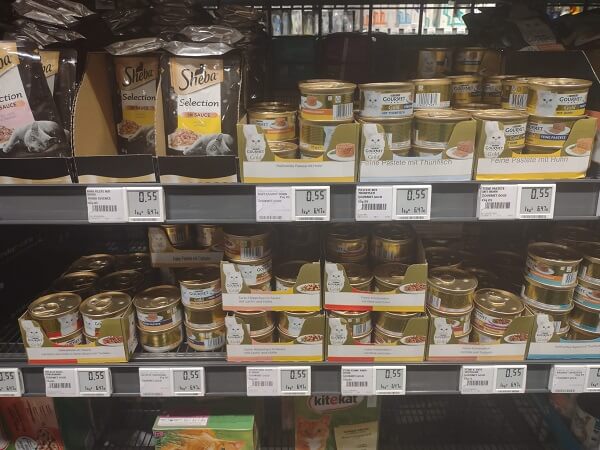
In Germany, specifically in the Rewe supermarket, I could get them from the brand Gourmet cat food. Other DIYers I heard speaking about tins of ham, small sausages, or paté. Have a look around and try out some cans if you’re having trouble finding a cat food can for the stove.
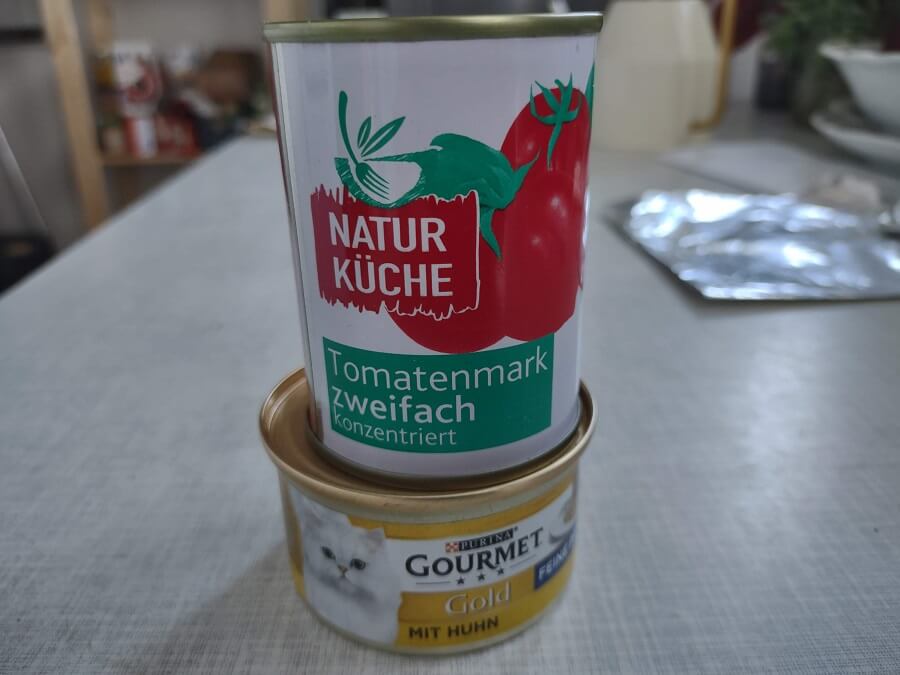
The tomato paste can was always a problem for me to find in the Netherlands, but I could get them easily in Germany. I have seen them in multiple supermarkets. There are not the standard small ones, but the ones that are a bit taller. Like pictured.
The Wicking Material
What makes the Fancy Feast Stove maybe a bit less approachable for many is the thought that you need Carbon felt for it. This is a material that can be quite expensive, depending on what you consider expensive. And a bit harder to find. Carbon felt is easily accessible via Amazon nowadays, and can be found in most hardware stores.
I however opted for the simple paper towel for my Fancy Feast Stove, and also tried out in the past a strip off an old pair of jeans, shirt, or other 100 percent cotton material. It all works and can be found already lying around in your house or dug up in the trash. The trick to making the paper or other flammable material last is to snuff out the fancy feast before it gets to its final sputtering flames. And stuff the material into the can so only a tiny bit is poking out. This makes it perhaps a little more difficult to light, but will not impact it much. In my testing, I did not notice any difference.
With any material you use, make sure you do your research on it. The following materials are OK to use:
| Carbon felt | Paper Towels |
| 100% cotton (Jeans, old shirts, etc.) | Fiberglass insulation |
| Steel wool | Fiberglass cloth / fabric |
Avoid any plastics or synthetic materials!
And as a final tip for the wicking, I suggest doubling up the material a few times, and presenting a folded edge on the top that you actually light. This will be more resistant and durable than a sharp or cut edge.
Fiberglass cloth and Insulation have their own problems, insulation hardens up over time, and Fiberglass Cloth is not so awesome for you in the long haul.
Assembly and testing
Assembly of the stove can be done with minimal tools, only make sure that you are careful around the sharp edges of the cut can. When you are not an adult get one to help you or look out. This can be, by the way, a fun weekend project for any parents with kids who are into the outdoors.
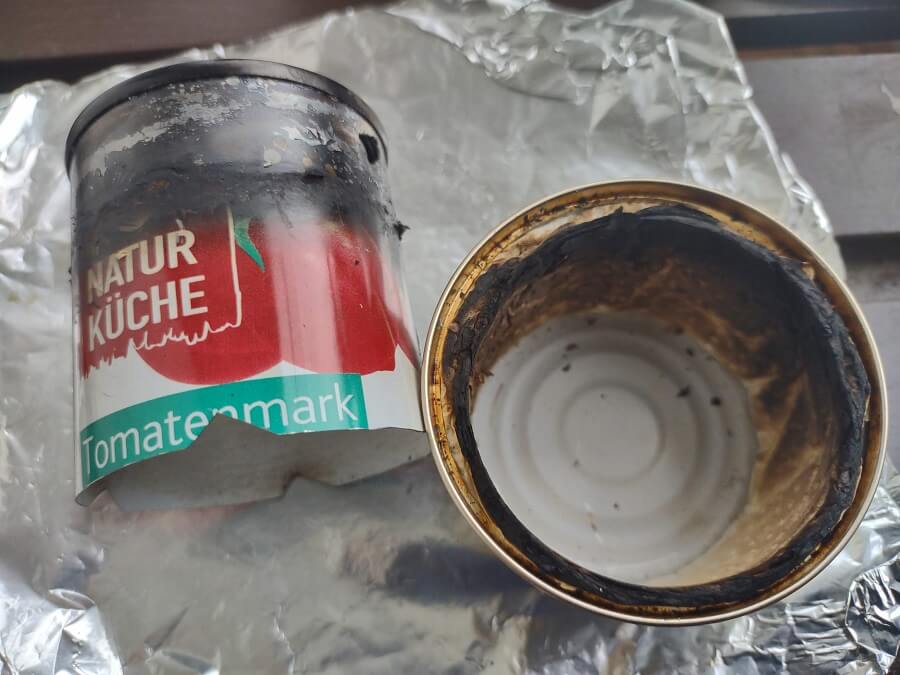
- Empty both of the cans and rinse them out
- Cut the bottom of the tomato paste can, so the still closed side.
- Trim the Tomato paste can until 2,5 centimeters is still above the cat food can when nestled inside.
- Poke breather holes into the top of the tomato paste can. This can be made prettier with a hole punch. At least one breather hole is essential, none will make alcohol spill out of the stove.
- Make notches in the bottom end of the Tomato paste can, 4 in total evenly spaced. This will allow the fuel to travel more easily to the wick.
- Wrap the wicking around the Tomato paste can, and with a twisting motion, stuff it into the Fancy feast can. Cut side down into the Fancy Feast can. Use a screwdriver to stuff any remaining wicking into the stove.
- That’s it! Go outside, and burn it for the first time. Don’t drink or eat anything from it during the first few burns. That way any impurities can burn off.
Safety stuff
- Never refuel the Fancy Feast Stove while still burning, if you do want to refuel, wait until completely out. Test this for example in the field with a sprig of grass over it for a solid 30 seconds.
- Alcohol is not easily identified as still burning in daylight, again, try a sprig of grass or another safe way of checking to see if it is burning.
- Never use any other fuel than alcohol in this stove. Pure Alcohol and Methanol are the fuels of choice. See my earlier articles on the subject for the full list and where to get it.
Ease of use of the Fancy Feast stove
What the Fancy Feast stoves have most going for them is the way they operate. For pretty much all cooking that you do on hiking trips you need to get water to the boil pretty quickly, and let boil for a minute or two. Let it sit for a few minutes, either in a cozy or just in the pot, and that is all. Alcohol stoves are therefore very practical because you can get water to the boil very quickly, and use very little fuel. That can be easier to replace than gas cartridges or white gas fuel as a bonus.
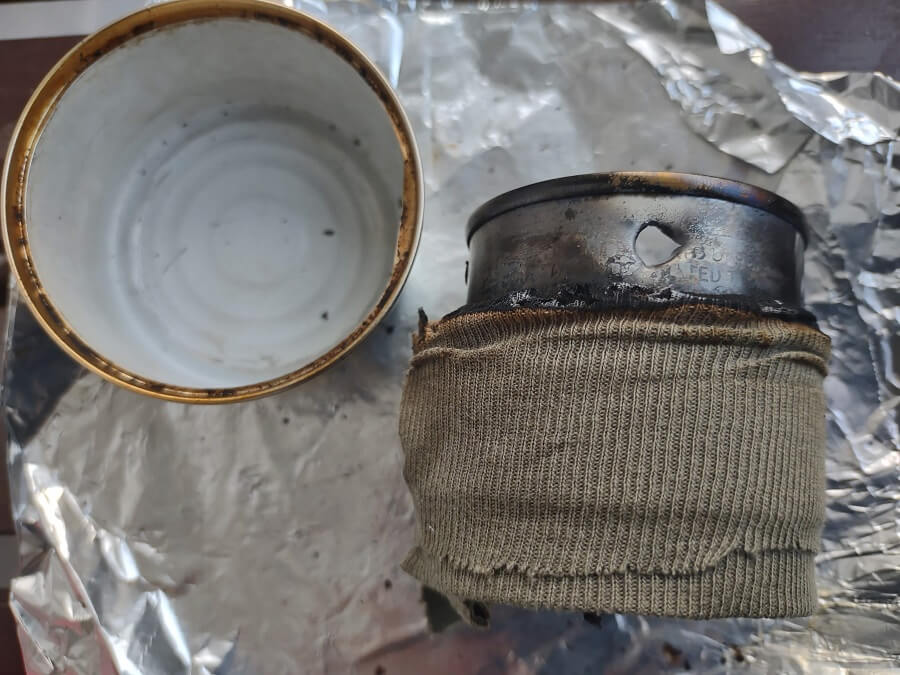
Other pressurized designs in alcohol stoves have often the flaw of having to prime them, even my beloved Trangia stoves require a minute or so to bloom up properly. But penny can stoves or other designs need a bit of extra fussing around to light up. Pressurized alcohol stoves, either with open or closed tops need that extra bit of time. With the Fancy Feast stove you don’t need any priming, just put in your required amount of alcohol, wait a few seconds and put your pot on. And light it up!
No priming, no being careful that the cold from the pot can put it out, nothing.
It’s one of the easiest Alcohol stoves out there, all you need is a windscreen to shield it. Other than that you don’t need to carry or make a pot stand or primer plate. It’s simple and therefore excellent.
The weight of the Fancy Feast Alcohol stove is depended on the wicking materials used, mine is 23 grams in total with a paper wick. 25 grams with the Cotton shirt wick.
Quick boil times
Boil times are always a bit slower than their gas or white gas counterparts for most alcohol stoves. But when talking about most uses, 500 milliliters of water in about 5 to 6 minutes in general. This means that you can have food fast, and crawl into your sleeping bag, or eat and get moving again in no time. Boil times are depended on a lot of different factors, from the temperature, elevation, exact height of the tomato paste can, wicking material, and fuel type. Make sure you test it out yourself at home before taking it out on the trail.
How well you protect it from the wind, if your pot has a lid, and the diameter of your pot, are also big factors in your boil times. I got varying results depending on those factors. The fastest was 4:40 minutes, slowest was 6:40 minutes. So take it with a grain of salt.
Long-lasting, and at the same time easy to replace
The Fancy Feast Alcohol stove will last a long time provided you dry it out after use. The one part that is vulnerable to rust is the steel or tin of the tomato paste can. And will over time wear out. This and the whole stove is however very easy to replace. From the Fancy Feast can or cat food can to the material you use for the wick. It’s all readily available and easy to replace with minimal effort. This makes the DIY alcohol stove route very easy to start, whatever your budget or experience.
Actually using the Fancy Feast Alcohol stove and learning how to cook with it in the most effective way is however a skill that you will need to learn. Learn what volume of alcohol is needed to boil your dinner on your stove and check to see what you typically cook in a day. With experience, you can take what you need on your next hiking trip, and don’t carry way too much or too less. I did an article about how the Fancy Feast Cook kit that I use, and you can read more about it in the link. Also make sure to check out my latest article on the subject, where I further improve the Fancy Feast Alcohol stove with a Rituals shower gel can.
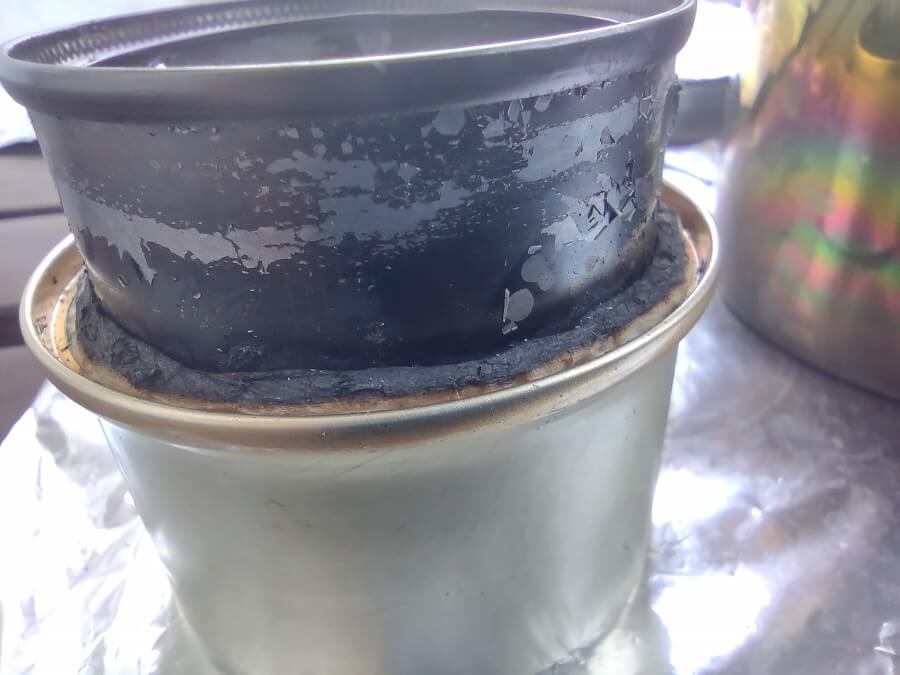
I could not have made this article work if it wasn’t for all the effort that Hiram Cooks on YouTube put in over the years. And I would like to thank him for all the ideas that make this stove one of the best for no-fuss alcohol stoves. I highly recommend going to his YouTube channel and checking out some of the videos he made on the subject.
More of my articles on Alcohol stoves can be found below and in the category Gear Reviews.
Improved Designs
See my latest Mark 2 and Mark 3 designs that further improve on the stove featured in this article.
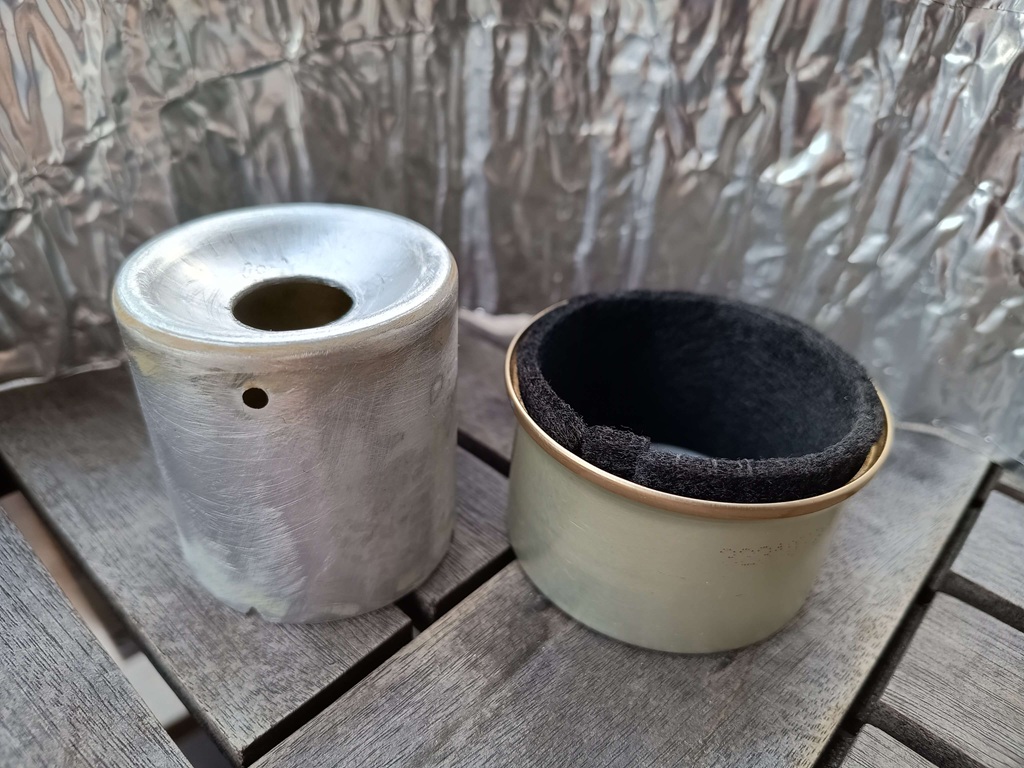
Happy Hiking and Hike for Purpose!



